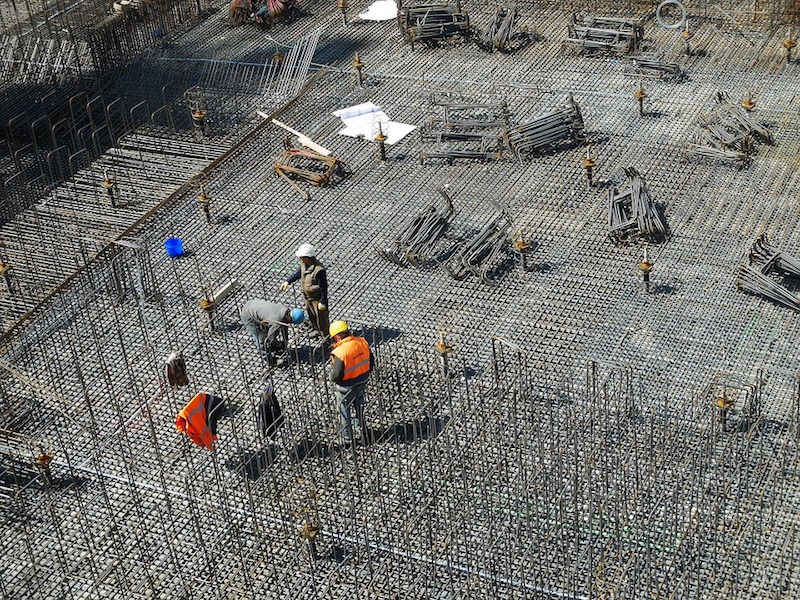Construction employment increased by 36,000 jobs in January to the highest level since August 2008, according to an analysis of new government data by the Associated General Contractors of America. Association officials said a possible new measure being discussed in Washington that would invest an additional $1.5 trillion in repairing and improving infrastructure would both help the sector continue to add jobs and attract new workers.
"The construction industry has consistently added workers at nearly double the rate of the overall economy," said Ken Simonson, the association's Chief Economist. "The outlook remains positive for further growth in the industry. But finding workers to complete all projects will be a challenge with unemployment so low overall and in construction."
Construction employment totaled 7,099,000 in January, a gain of 36,000 for the month and 226,000, or 3.3%, over 12 months. The economist pointed out that the year-over-year growth rate in industry jobs was more than double the 1.5% rise in total nonfarm payroll employment.
Residential construction—comprising residential building and specialty trade contractors—added 19,000 jobs in January and 88,400 jobs, or 3.3%, over the past 12 months. Nonresidential construction (building, specialty trades, and heavy and civil engineering construction) employment increased by 16,400 jobs in January and 137,200 positions, or 3.3%, over 12 months.
The number of unemployed jobseekers with recent construction experience fell to 707,000 in January, down from 859,000 in January 2017, while the unemployment rate in construction dropped to 7.3% last month from 9.4% a year earlier. The number and rate were the lowest for January since the series began in 2000. Unemployment data by industry are not seasonally adjusted, and winter figures for construction are normally higher than they are for total nonfarm employment, but these declines show how difficult it has become for the industry to find experienced workers, Simonson said.
Average hourly earnings in the industry climbed to $29.33, a rise of 2.9% from a year earlier. The economist noted that construction pays nearly 10% more per hour than the average nonfarm private-sector job in the United States.
Construction officials said that a new presidential push to boost infrastructure investments by $1.5 trillion over the next ten years would give a needed boost to infrastructure contractors who, according to construction spending figures released yesterday, have seen lagging demand compared to other market segments. Moreover, significant new and long-term investment in infrastructure would help encourage more people to consider high-paying careers in construction.
"Bringing our aging infrastructure back to a state of good repair will support short-term economic growth while making our economy more efficient and competitive over the long-term," said Stephen E. Sandherr, the association's Chief Executive Officer. "These new investments will also send a clear signal to new workers to consider careers in construction and the middle-class life those jobs support."
Related Stories
MFPRO+ New Projects | Apr 8, 2024
Construction complete on The Station Apartments in Minneapolis
Big-D Midwest recently completed construction on The Station Apartments at Malcolm Yards, an innovative and unique housing property in Minneapolis.
Green | Apr 8, 2024
LEED v5 released for public comment
The U.S. Green Building Council (USGBC) has opened the first public comment period for the first draft of LEED v5. The new version of the LEED green building rating system will drive deep decarbonization, quality of life improvements, and ecological conservation and restoration, USGBC says.
Codes and Standards | Apr 8, 2024
Boston’s plans to hold back rising seawater stall amid real estate slowdown
Boston has placed significant aspects of its plan to protect the city from rising sea levels on the actions of private developers. Amid a post-Covid commercial development slump, though, efforts to build protective infrastructure have stalled.
Adaptive Reuse | Apr 5, 2024
McHugh Construction completes restoration of Chicago’s historic Ramova Theatre
Adaptive reuse project turns 1929 cinema into a live performance venue, adds a brewery and a taproom, and revives the Ramova Grill in Chicago’s Bridgeport neighborhood.
Retail Centers | Apr 4, 2024
Retail design trends: Consumers are looking for wellness in where they shop
Consumers are making lifestyle choices with wellness in mind, which ignites in them a feeling of purpose and a sense of motivation. That’s the conclusion that the architecture and design firm MG2 draws from a survey of 1,182 U.S. adult consumers the firm conducted last December about retail design and what consumers want in healthier shopping experiences.
Sustainability | Apr 4, 2024
Skanska Elevates Commitment to Sustainability
Skanska, a global leader in sustainable building, has restructured its Sustainability Team to better serve client and company goals. Co-led by Steve Clem and Myrrh Caplan, who together bring decades of experience, the team will allow Skanska to continue to set the bar for the industry.
Codes and Standards | Apr 4, 2024
How Washington, D.C.'s Zero Waste DC Plan impacts building owners and design professionals
On February 8, 2024, Mayor Muriel Bowser presented the Zero Waste DC Plan to the Council, outlining policies, programs, and initiatives to meet the District’s aim of reducing per capita waste generation by 15% and transitioning from a disposable culture to a circular economy. Of the 43 actions in the plan, a handful are essential for building owners and design professionals to know about now.
Healthcare Facilities | Apr 3, 2024
Foster + Partners, CannonDesign unveil design for Mayo Clinic campus expansion
A redesign of the Mayo Clinic’s downtown campus in Rochester, Minn., centers around two new clinical high-rise buildings. The two nine-story structures will reach a height of 221 feet, with the potential to expand to 420 feet.
K-12 Schools | Apr 1, 2024
High school includes YMCA to share facilities and connect with the broader community
In Omaha, Neb., a public high school and a YMCA come together in one facility, connecting the school with the broader community. The 285,000-sf Westview High School, programmed and designed by the team of Perkins&Will and architect of record BCDM Architects, has its own athletic facilities but shares a pool, weight room, and more with the 30,000-sf YMCA.
Market Data | Apr 1, 2024
Nonresidential construction spending dips 1.0% in February, reaches $1.179 trillion
National nonresidential construction spending declined 1.0% in February, according to an Associated Builders and Contractors analysis of data published today by the U.S. Census Bureau. On a seasonally adjusted annualized basis, nonresidential spending totaled $1.179 trillion.

















